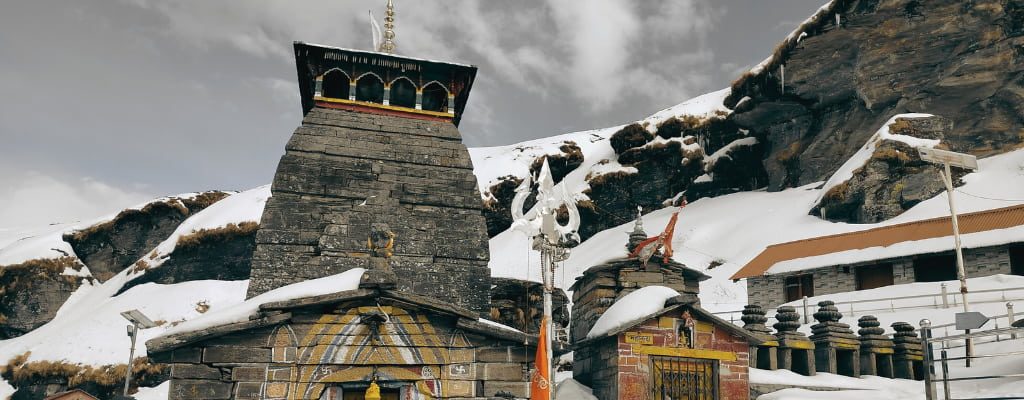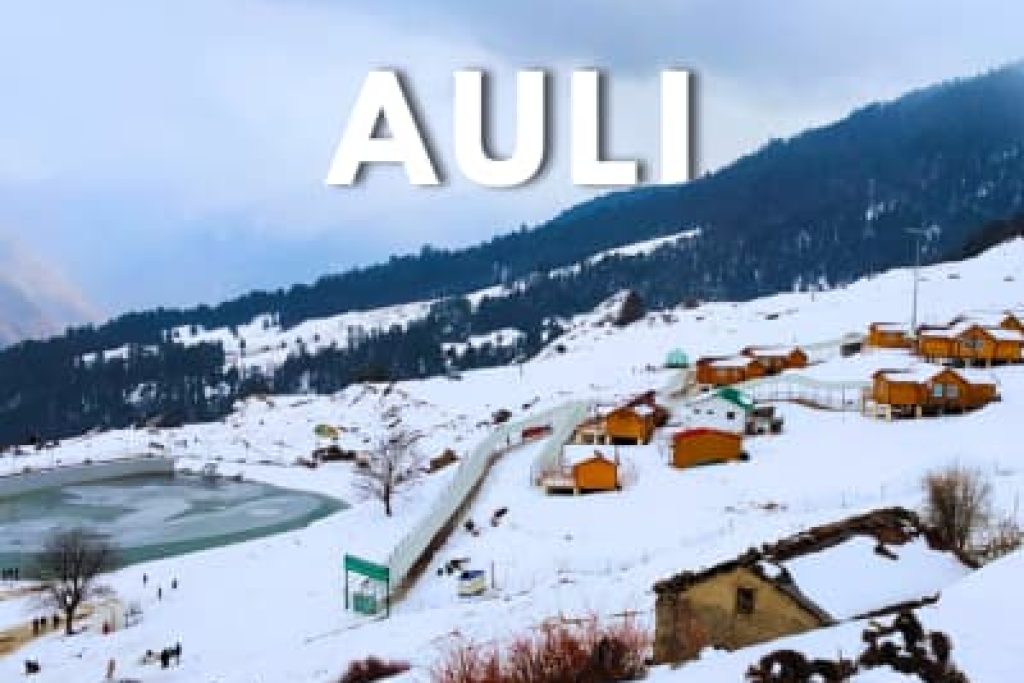
Tungath - World's highest Shiva Abode
Tungnath Mahadev Temple, the highest Shiva temple in India, even of the entire world, is a destination many of us have longed to visit. On the other hand, there may be others who haven’t even heard of it. Somewhere deep down, this is the reason why this place remains relatively less crowded, and seekers of peace ultimately find their way here.
Tungnath Mahadev Temple, a sacred destination, lies in Uttarakhand’s Rudraprayag district. Tungnath Temple is an integral part of the Panch Kedar circuit, with its importance and references abound in various ancient Hindu texts and mythologies.
Historical Background of Tunganth Temple

Association with Post-Mahabharat Era
The Tungnath Temple is believed to be over 1,000 years old and is considered the third Kedar among the Panch Kedar. The temple has strong links to the Pandava brothers, the legendary heroes of the Mahabharat, and is particularly connected to the post-Mahabharat war era. The epic Mahabharata War resulted in immense destruction and loss of life, as countless individuals sacrificed their lives. The inherent rule of war is that one side will emerge victorious, while the other will succumb to defeat. Another disheartening aspect of this war was that both sides belonged to the same family; on one side were the Kauravas, while on the other side were the Pandavas.
Lord Krishna’s Instructions
When all the Pandvas were disheartened by whatever happened in the battle of Kurukshetra, they first approached Lord Krishna, and sought a solution to free themselves from this sin of this. Lord Krishna told them, “You have only one path to atonement; you must meet Mahadev who is unhappy with your deeds, for in him lies your sole hope for forgiveness.”

The Pandavas Quest for Forgiveness
The Pandavas were tormented by the anguish of having to take the lives of their own family members, Brahmins, and even Bhishma Pitamah with their own hands due to the war. They were deeply hurt by this and therefore, all the brothers sought to atone for their actions. For this, they chose a path, relinquished their entire Kingdom, and began searching for Lord Shiva, so that they could worship him and be freed from their past wrongdoings

Pandavas Arrival in Kashi
The Pandavas arrived in Kashi, but their meeting with Mahadev did not materialize, as Mahadev had departed for the Himalayas. All the Pandavas followed him till Kedar, and after that only Mahadev transformed his form and became a bull.

The Anger of Lord Shiva
When Pandavas finally arrived, they found that Mahadev was displeased and angered by their past actions, and therefore, He took the form of Nandi (His divine bull) and hid in Uttarkashi, in the Garhwal region of Uttarakhand, concealing his true identity to avoid detection. Through sheer determination and tactics, Bheem finally recognized the unusually appearing bull, realizing it was none other than Mahadev Himself. As soon as Bhima approached, Mahadev (in his bull form) began to disappear and sank into the earth, leaving behind only his hump.

Pandavas Find Redemption
Mahadev’s heart was eventually softened by their unwavering devotion, and he granted forgiveness to the Pandavas. Thereafter, Mahadev’s divine presence took the form of arms at Tungnath, that shrine was that time erected by the eldermost Pandava brother Yudhishthir. While the other side says, the foundation was laid by Arjuna, the third of the Pandava siblings.

Tungnath Opening & Closing Date 2024
Tungnath Temple is located in remote area of Chopta and receive high snowfall which makes the area inaccessible. Every year the temple open only for 6 months in year.
Tungnath Opening Date – 14 May-2024
Tungnath Closing Date – 4 Nov 2024
Who Built Tungnath Temple?
Initially, this temple was founded by the Pandavas along with other Panch Kedar temples. Later, in the 8th century, Adi Shankaracharya reconstructed the temple, who was a pivotal figure in Indian history, as a renowned Hindu philosopher and reformer he contributed to preserving our culture and its associated traditions. Even, it is also said that this temple has been renovated several times by local kings and queens.
Key Features of the Tungnath Temple
- Highest Shiva Temple in the World.
- Tritya Kedar; The third jewel in the crown of Panch Kedar.
- Asia’s highest Shivalaya, a singular ancient shrine situated at the continent’s loftiest elevation.
- Ancient temple associated with the 10th century.
- The Tungnath mountains (lord of the peaks) encompass the Mandakini and Alaknanda river valleys.
- Declared Monument of National Importance by Central Govt. in 2023.
- Stunning architecture and scenic views.
- The trekking path affords breathtaking views of the Himalayas.
Tungnath Temple as an Architectural Marvel
- Style of Architecture: The Nagara style of architecture
- Ornamentation: The temple is constructed from stone and intricately painted interior and exterior surfaces, complemented by imposing towers
- The Art in Roof: The Roof features stone slabs with intricate wooden carvings
- Venerable sculptures and carvings depicting Hindu deities and mythological characters.
What are Cultural Significance & Practices?
Mahashivratri or Shiva Ratri Festival→It is celebrated with great fervor, and if you get a chance to visit here at this time, it would be an excellent experience.
Tungnath Mahadev Fair→ In April or May, the temple reopens for devotees, and the inaugural or opening ceremony features the impressive organization of the Tungnath Mahadev Fair, drawing the attention and fascination of a large crowd of locals and other devotees. The air of that region is filled with divinity as, you will hear chants of mantras, bhajans, and other traditional or devotional songs. The locals gather to perform sacred rituals and display their cultural traditions via cultural performances. If you are a shopaholic, then you will be delighted to find the local handicrafts, religious artifacts, and more. Additionally, you can also try the local traditional cuisine.
Palces to visit Near Tungnath
Tungnath, the highest Shiva temple in the world, is surrounded by several captivating spots in Uttarakhand. A must-visit is Chandrashila a peak just 1.5 km from Tungnath, offering panoramic views of the Himalayas, including Nanda Devi and Trishul peaks. Deoria Tal is a serene lake nearby, famed for its reflection of the Chaukhamba peaks and an excellent site for camping and stargazing. Rohini Bugyal is a lush alpine meadow, perfect for trekkers seeking tranquility amid nature. Nearby, the town of Chopta serves as the base for exploring the region, known as the “Mini Switzerland of India” for its breathtaking views and biodiversity.
Best Time to Visit Tungnath

Summer Season (April to August)
During this time, a large crowd of tourists is visible, as it’s a peak season due to the comfortable temperature and lush greenery surrounding the mountains. The snow-capped mountain peaks glisten, creating a breathtaking sight, along with cool crispness of the air around will captivate your senses.

Monsoon & Autumn (Sep to Nov)
During monsoon, the rain makes the Tungnath route somewhat difficult, but if the rain is moderate and you are fully prepared, there is no issue traveling. In fact, the colorful-green meadows, Alpine trees, and stunning wildflowers along the way will mesmerise you.

Monsoon & Autumn (Sep to Nov)
Although the cold is intense and heavy snowfall is prevalent, Tungnath’s darshan remains uninterrupted. If you wish to behold the divine amidst snow-clad surroundings, you can visit the Tungnath Temple in winters. Trekking becomes somewhat challenging, but if you enjoy taking on challenges and priortise safety measures, then there’s no issue.
How to Reach Tungnath
Since Auli is a hill station, so is in a remote location, accessing it requires utilizing multiple transportation options. Auli can be easily reached by road from Jolly Grant Airport, Dehradun, where you can hire a private taxi to reach Auli directly.

By Air
Jolly Grant Airport, Dehradun- Take flight from your nearest airport to reach Dehradun Airport. Hire a taxi or bus from Dehradun Airport to reach Chopta. Then, your trekking journey begins from Chopta

By Rail
Haridwar/Rishikesh is the nearest Railway Station. After reaching Haridwar or Rishikesh, hire a taxi or bus to reach Chopta. And trek 3-4 km to reach the Tungnath mandir.

By Road
Hire a bus or taxi or shared cab from Haridwar/Rishikesh to Chopta (and if you’re coming through public transport then come to Ukhimath because no direct option to Chopta. After Reaching Ukhimath book a shared taxi to Chopta.) From Chopta, start trek for Tungnath Dham which is 3-4 km long.
Travel Route
After reaching Rishikesh, you will proceed on this travel route by road to complete the remaining journey.
Haridwar → Srinagar → Rudraprayag →Chopta → Tungnath
The Tungnath Temple Journey
To reach Tungnath Temple, you need to trek, and before embarking on this amazing journey, you must complete your driving journey up to Chopta. Chopta does not have a railway connection, however, it is well-connected by road and can be reached from any location. As a result, you will find the journey to Tungnath thoroughly engaging and interesting. At times you will be on a train, then in a taxi, navigating the mountain roads, and finally, after an exhilarating trek, you will arrive at Tungnath. The initial stretch of the trek can be navigated on horseback, providing a convenient option for senior citizens or individuals with physical limitations.
Tungnath Winter Trekking
Tungnath Trek, a 4-5 km journey through the scenic Chopta region in Uttarakhand, takes you to the world’s highest Shiva temple, situated at an elevation of 3,680 meters. This moderate trek leads you through lush meadows, dense forests, and offers breathtaking views of the Himalayas. As you ascend, the tranquil ambiance of Tungnath Temple awaits, a site revered for both its spiritual significance and natural beauty. Perfect for nature lovers and spiritual seekers alike, the trek is a harmonious blend of adventure and serenity.
December and January are perfect months to visit Tungnath, offering a distinct delight for snow lovers and those seeking to experience winter’s pristinity after visiting in summer’s vibrancy. Meanwhile, many adventurous souls also exist who first plan for Chopta only, but change their minds to add Tungnath also in their itinerary. The simple reason is that they realize Tungnath is one of the top winter treks, so they cannot miss such a worthwhile experience.
Weather & Temperature of Tungnath
Tungnath’s weather changes multiple times throughout the year, showcasing a unique facet in every reason. The winters bring biting cold with snowfall, while the summers offer refreshingly pleasant temperatures. During monsoon, Tungnath’s weather brings moderate level rainfall, and the temperatures are mild, thus this period is considered off-season for the tourists but yes the lush green landscapes and serene atmosphere is perfect to surrender yourself to nature.
- Tungnath in December – December brings extreme winter to Tungnath, with temperature fluctuating between -1 °C to 5°C during the day and -3°C to -6°C at night. Heavy snowfall occurs during this period, so roads become treacherous. Ensure you are well-prepared with appropriate clothing and footwear for trekking, cold weather, and strong winds
- Tungnath in January – In January also, Tungnath will give you a winter wonderland experience, the temperature will range from -5°C to 10°C accompanying with heavy snowfall, but with amazing vistas, its beauty i winter is beyond comparison.
Travel Tips for Auli Trip
- Research about the Destination: Gather information about the trekking routes, and accommodation options through reviews & ratings, and local transportation.
- Decide your Best Time: Winters for snow lovers, Summers for trekkers
- Duration: Plan for at least 4-5 Days to explore the place
- Advance Booking: As staying options are limited, the prices rise significantly during peak season, make sure to book your Accommodation and transportation beforehand so that you may not face any difficulties.
- Monitor the weather forecast: The roads are susceptible to frost, causing normal vehicles to slip. If you are an experienced driver, then only opt for self-drive, and with a 4×4 car, the drive to such paths becomes easier, as they are capable of handling such conditions on Himalayan Roads. Keep checking the weather updates so that you can be mentally and physically prepared before heading out.
- Hiring a Skilled Local Driver: It’s better to come with an expert & skilled local driver, as they know how to manage such mountainous roads, and even their vehicles are well equipped with safety features for slippery roads.
- Start Early: If you travel on time, you will complete your journey comfortably within the planned schedule. Certain destinations look best during the serene morning hours and others during the enchanting evening.
- Respect Nature & Environment: Since you are a nature lover, then be a responsible tourist and respect the beauty and sanctity of that place, preserving its natural charm for future generations.









Comment (0)